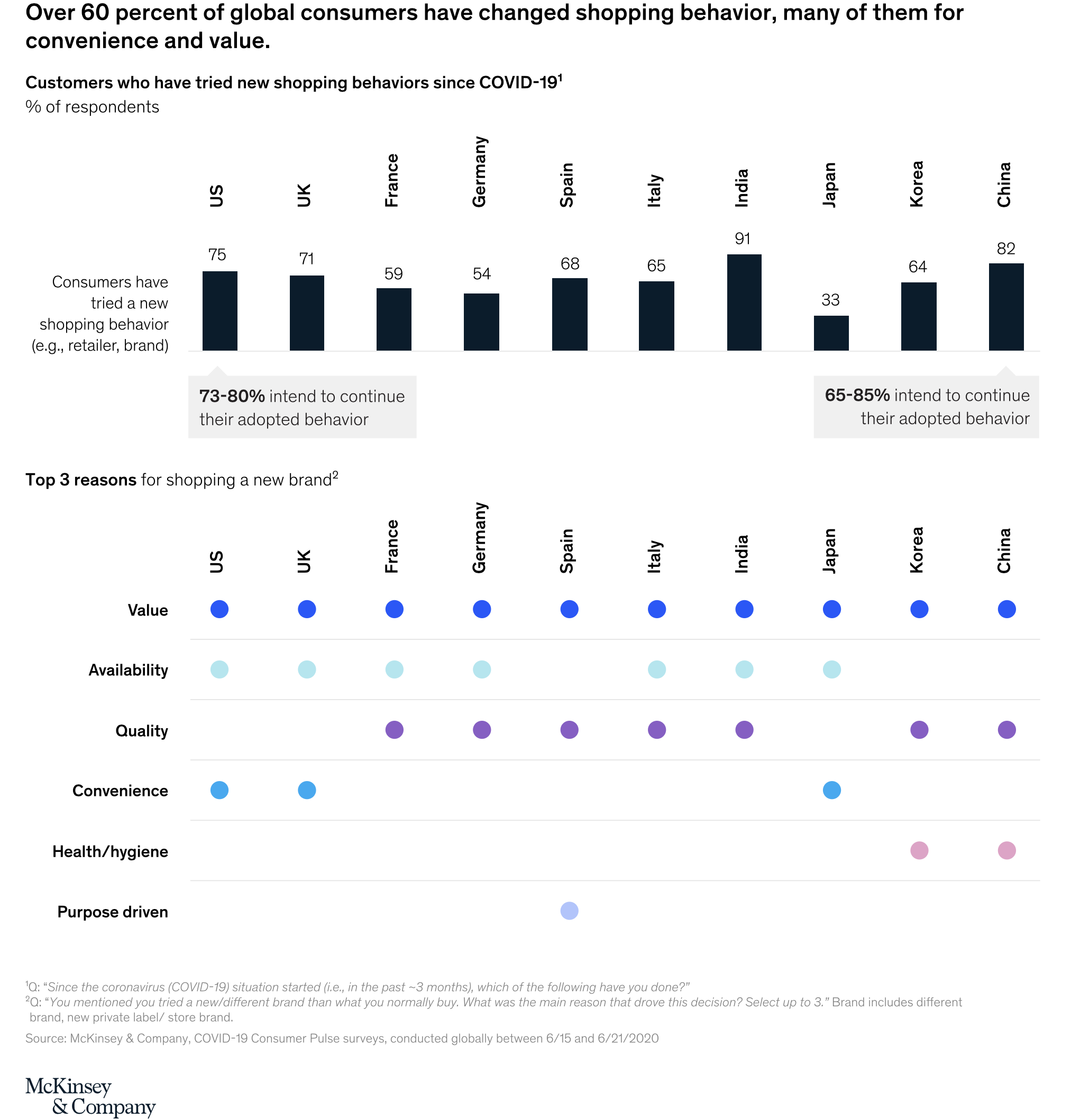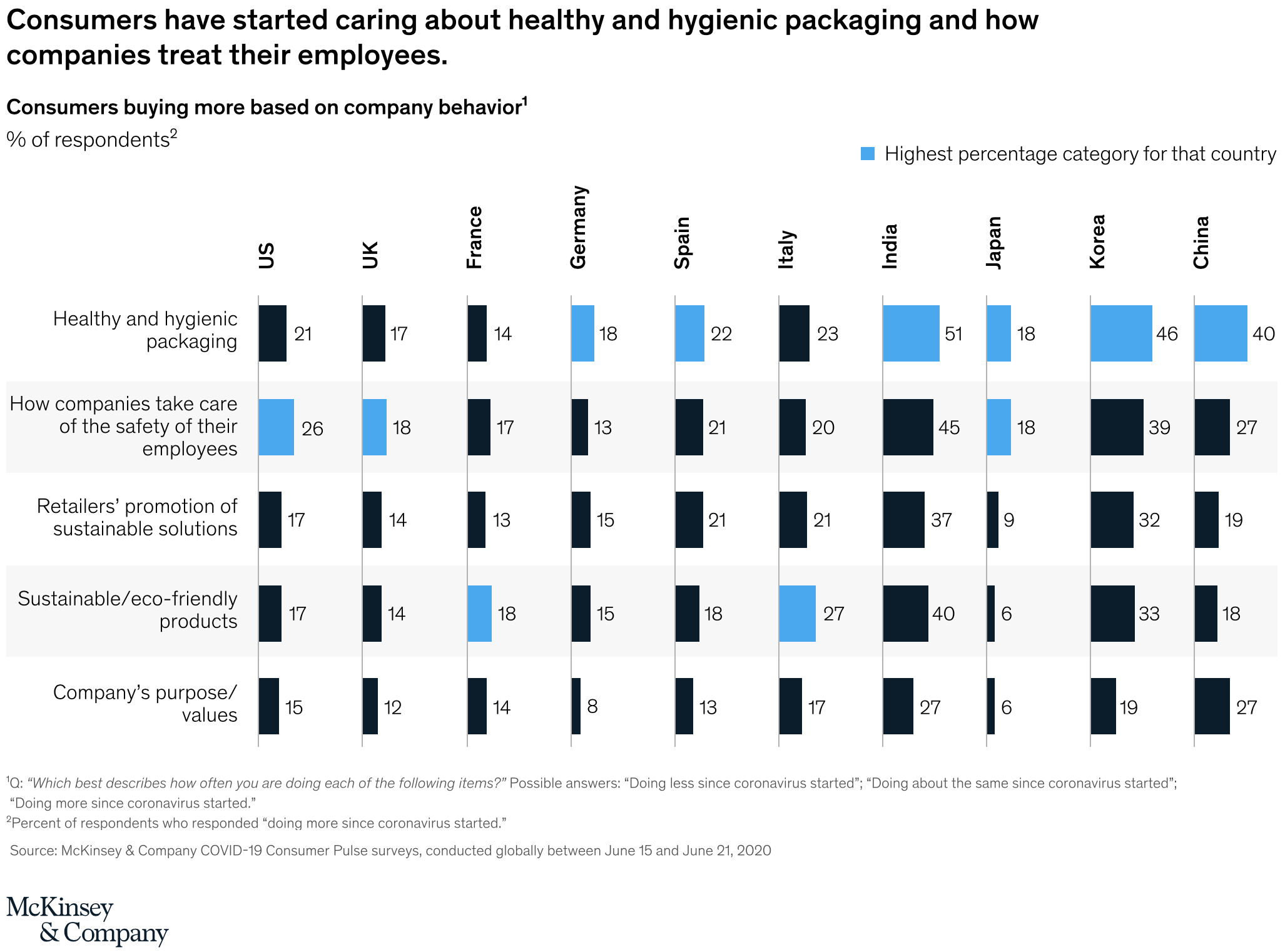The Covid-19 crisis imposed tremendous changes to the day-to-day life of billions of people around the world. The societal and economic effects of the pandemic have touched everyone’s lives in one way or another and have immensely transformed how consumers shop and how retailers sell. Many of these behaviours are expected to become more permanent in the post-crisis retail landscape.
These new trends and the ones that will re-emerge due to the pandemic will shape the consumer behaviour in the new normal and consequently, they will change the way businesses operate and how they approach and interact with their customers. Understanding which of these trends will stick and adapting your business model to them will be essential for a brand not merely to recover but also to emerge stronger from the pandemic. For retailers to thrive in the post-Covid-19 landscape, updated business models and practices are crucial.
Accelerated underlying trends
The pandemic undoubtedly caused a great shock to most retailers and forced them to question what shape the retail industry will take in the near future. By some estimates, we have jumped ten years ahead in consumer and business digital penetration in less than three months. For most businesses, a certain level of structural change was required, and a significant number of them will have to pivot to new models in order to survive.
Nevertheless, it is gradually becoming more apparent that the pandemic has accelerated underlying trends and issues that were known to the retail sector for many years now. The brands that will manage to survive the crisis will be the ones that are willing to embrace new business models and technologies, as well as understand and remain focused on their customers’ ever-changing needs and behaviours.
Consumer sentiment
People around the world slowly start to learn how to live with the realities of Covid-19 as countries gradually reopen their economies. As people’s lives and habits begin to settle into the new normal, so does their consumer behaviour.
In the UK, non-essential retail stores started re-opening on June 15th, and extensive queues in front of stores were reported, long before opening times. These enormous queues outside IKEA, Primark, and other stores could lead us to believe that the recovery of the retail sector would be swift. Unfortunately, the reality may be far from it; the experience of adhering to numerous strict social distancing and safety measures may prove unappealing in the long-term, and store-based shopping seems to be nowadays more of a functional activity rather than a recreational one.
Although the coronavirus’ impact has varied between different countries and regions, certain pandemic responses appear to become common ground among consumers across the globe. In the UK, like in most countries, people are not feeling particularly optimistic about economic recovery. Restrictions on physical stores, rising unemployment levels, the looming threat of a second wave of Covid-19, and the uncertainty of the ongoing Brexit negotiations, will suppress consumer confidence and spending.
The majority of UK consumers still believe that the pandemic situation will continue to impact their finances for the next few months, and it will take more than two months before their routines will return to normal. As a result, consumers will continue directing their spending mainly on essentials, such as grocery and household supplies, and avoid expensive products and services. Nevertheless, discretional spending has started to recover slowly, but it remains low in certain categories like apparel, footwear, and travel.
Brand loyalty
The pandemic has also caused a one-in-a-lifetime shock to brand loyalty. The supply-chain disruption caused by Covid-19, especially during the first months of the pandemic, forced many consumers to try new brands or shop from different retailers when they could not access their favourite products at their preferred shops. A significant number of consumers globally have tried new brands and retailers during the lockdown, and they continue to do so nowadays, with the vast majority of them intending on sticking with the new brands in the long term.
Most of this behaviour change has occurred when buying essentials, with value, availability, and quality being the main reasons for choosing a different brand. Therefore, it is of the utmost importance for retailers to be in a position to take advantage of this scarce opportunity to reboot brand loyalty. Brands need to be able to identify what consumers value these days, adjust their offering to these new findings and win the customers over.

Increase in online shopping
Another trend that is likely to stay post-pandemic is the shift to digital. The lockdown has acted as an accelerant for e-commerce across all product categories, which will also speed up the evolution of inventory, order, and supply chain management software and practices in general. On top of more consumers intending to continue to shop online post-crisis, there is an increasing embracing of various contactless services like click-and-collect or curbside pickup.
It is true that in recent years, many retailers were striving to reimagine their brick-and-mortar stores to create more immersing, personalised shopping experiences for their customers. Now that product and person engagement in physical stores are limited, most of this investment should be channelled into the e-commerce side of the business, as an answer to the growing need for ‘added-value’ shopping experiences within digital formats.
In this ever-changing, extremely high competitive landscape, businesses need to embrace the latest innovations and trends to move ahead of the competition. Shoppers are nowadays way more price-conscious than before and seek for a more personalised, omnichannel shopping experience. Augmented reality and omnichannel strategies’ increasing popularity is starting to take the e-commerce industry to the next level. If adopted, they could allow retailers to step-up their digital game, help them compete with e-commerce giants and discounters like Amazon or Walmart, and capture as much of the rise in online shopping as possible.
Health and care awareness
Consumers are nowadays more aware when it comes to hygiene and prevention, and they are actively looking for retailers that make use of increased safety measures like the use of masks, enhanced cleaning procedures, implementation of in-store physical barriers, and more. Equally, many consumers prefer to spend as little time as possible in public spaces. Hence, they value more easy-to-navigate stores with helpful and knowledgeable staff that offer self-checkout options. Additionally, companies’ care and concern for their employees’ wellbeing, local communities, and society in general, as well as sustainability and environmental-friendly practices are essential buying factors for an increasing number of consumers these days.

Local services and value retailers
With a significant segment of the workforce still working from home, people travel less far and less often. As a result, we witness a rise in localised shopping as people depend more on local services and amenities. A recent survey shows that there has been a 27% net increase in positive public perception due to corner shops’ pivotal role in providing essential goods and services during the lockdown. Moreover, it was the smaller stores that reopened most quickly after the lockdown restrictions were lifted. Due to high rents and limited football, larger shops were quite cautious at first about the economics of reopening.
Until the big downtown shopping destinations manage to recover, we believe that local shops’ revival will continue. Furthermore, with a long period of financial uncertainty ahead of us and unemployment levels rising, consumers will be more selective about what they buy and from whom. Consequently, discounters, value retailers, and direct to consumer (D2C) brands offering home essentials will experience a shift growth; especially the ones with a robust online presence.
Conclusion
Undoubtedly, the impact of the pandemic has been monumental for the retail industry and has immensely accelerated several underlying trends but also highlighted long-term structural issues. The Covid-19 crisis has drastically altered how people shop and how retailers sell.
Yet, not all the consumer behaviour changes that the pandemic gave birth to will stay for the long term; much will depend on the severity of the recession, demographics, the consumers’ ability and desire to spend in the days to come, how satisfied people are with the new purchasing experiences and options available, and more.
Nevertheless, trends like the shift to more immersive and personalised online shopping experiences are more likely to be permanent. In the short run, as these new behaviours begin to solidify, brands that fully comprehend these trends and have the ability and ambition to adapt their business model accordingly will have the opportunity to attract and connect with consumers in new ways that are in sync with their newly-formed shopping habits and decision-making journeys.
These companies will not merely manage to recover; they will emerge stronger from the pandemic.